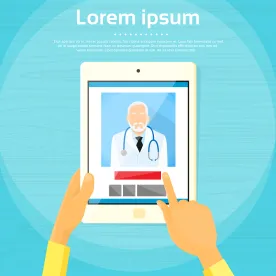State legislation is heavily contributing to the expected reimbursement/coverage uptick in 2016, as more states consider legislation requiring coverage for telemedicine and in-person visits alike.
To date, 29 states and Washington D.C. have enacted legislation ensuring that private insurers offer reimbursement for telemedicine at equivalent levels with in-person services, provided the care is deemed medically necessary. Many of the laws enacted in 2015 will take effect in January 2016.
In the past year, more than 200 pieces of telemedicine-related legislation have been introduced in 42 states. Not surprisingly, these legislative approaches to telemedicine vary widely, but there are four common telemedicine delivery methods states are considering as part of ongoing legislation in 2016:
-
Synchronous Audio and Video
Under telemedicine coverage and practice regulations, real time audio-video is considered the gold standard for telemedicine delivery. A close second, accepted across many states, is interactive audio with asynchronous data transmission of the patient’s medical information. There are many situations where synchronous audio-video is neither feasible nor clinically necessary for appropriate medical action (e.g., teleradiology and telepathology both use asynchronous tech). Yet, even for synchronous audio-video, there remains variation among states regarding how, when and where these services are covered. For example, some states allow patients to conduct video consults from any location, whereas some mandate the patient be located at a qualifying originating site or a rural area. The trend, however, is to remove these artificial barriers and allow coverage of telemedicine consults regardless of the patient’s location.
-
Remote Patient Monitoring
Remote patient monitoring (RPM) is, by nature, a service without in-person equivalent. Therefore, very few states include RPM in their commercial insurance coverage laws, with some exceptions being Delaware and Mississippi. Similarly, fewer than two dozen states offer Medicaid FFS coverage of RPM services. Moving into 2016, as payers and providers recognize telemedicine’s cost-savings benefits for patients with chronic illnesses and push for it, and as better home health care technologies proliferate, we are sure to see more legislation requiring coverage for RPM. One place to look will be states with older telehealth coverage laws, as providers in those states may push for an update to those laws to include RPM. For an overview of the telemedicine regimes in every state, see the Center for Connected Health Policy’s July 2015 report.
-
Asynchronous (Store and Forward)
Store and forward – the electronic transmission of medical information, including pre-recorded videos, images, and documents – is covered only by a minority of states because most have defined telemedicine as “occurring in real-time,” or “using live video.” Fewer than a dozen states expressly mandate coverage of store and forward telehealth in their commercial coverage laws. But in those states that do cover store and forward, insured patients can enjoy a powerful and convenient care benefit. Examples include Colorado, Connecticut, Hawaii, Montana and several more. Approximately the same number of states include coverage of store-and-forward in their Medicaid FFS program benefit.
-
Cross-State Services
Another purported limitation on telemedicine expansion is state physician licensure requirements, meaning that physicians are not permitted to practice across state lines unless duly licensed. Whether state licensure truly is a material obstacle to telemedicine remains to be seen, as many providers have built (and are building) robust multi-state telehealth service offerings using professionals licensed in the states where the patients are located. That said, changes are on the way, as eleven states have already adopted the Federation of State Medical Boards (FSMB)’s Interstate Medical Licensure Compact with bills pending in nine more states, though its effective date is pending.
Combined with revised federal Medicare rules, favorable state laws and board rules have the power to significantly grow telemedicine use and availability – something we expect will occur throughout 2016. Expanding state legislation is among five telemedicine trends driving health care transformation in 2016 and beyond. Next, we will cover retail clinics and employer onsite health centers on the rise.




 />i
/>i

